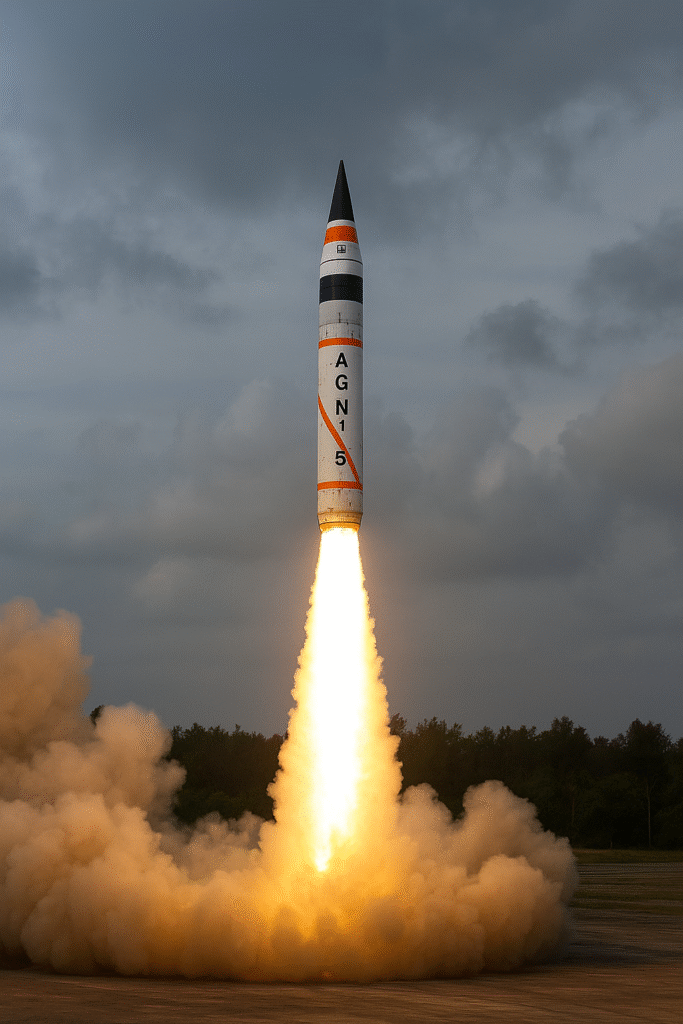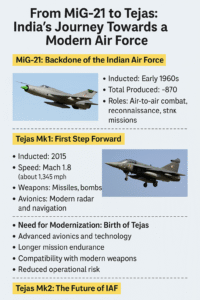In the heart of Odisha, on August 20, 2025, India achieved a significant milestone in its defense capabilities. The successful test-firing of the Agni-5 intermediate-range ballistic missile (IRBM) from the Integrated Test Range in Chandipur marked a pivotal moment in India’s strategic defense posture. With a range exceeding 5,000 kilometers, the Agni-5 can reach targets deep within Asia and parts of Europe, including northern China and Turkey.
Developed by the Defence Research and Development Organisation (DRDO), the Agni-5 is a testament to India’s growing technological prowess and commitment to maintaining a credible minimum deterrence. This missile not only enhances India’s defense capabilities but also contributes to regional stability by reinforcing deterrence against potential threats.
Agni-5 Ballistic Missile Range and Capabilities
1. Extended Range and Precision
The Agni-5 boasts an impressive range of over 5,000 kilometers, allowing it to target adversaries deep within Asia and parts of Europe. This extended reach ensures that India can project power and maintain strategic deterrence across a vast geographical area.
2. Multiple Independently Targetable Re-entry Vehicle (MIRV) Technology
Equipped with MIRV technology, the Agni-5 can carry multiple nuclear warheads, each capable of striking different targets independently. This capability significantly enhances the missile’s effectiveness and complicates any potential adversary’s defense strategies.
3. High Accuracy and Reliability
The Agni-5 is designed for high accuracy, with a reported Circular Error Probable (CEP) of less than 10 meters. This precision ensures that the missile can accurately strike designated targets, minimizing collateral damage and maximizing strategic impact.
Development History of Agni-5 Ballistic Missile in India
1. Indigenous Development by DRDO
The Agni-5 was developed indigenously by DRDO as part of India’s Agni missile series. The series began with the Agni-1 in 1983 and has progressively advanced to the current Agni-5, reflecting India’s growing capabilities in missile technology.
2. Successful Test Flights
The Agni-5 has undergone several successful test flights, demonstrating its reliability and effectiveness. These tests have validated the missile’s design and performance, ensuring its readiness for deployment.
3. Strategic Integration
Following its successful development and testing, the Agni-5 has been integrated into India’s Strategic Forces Command, enhancing the nation’s nuclear deterrence capabilities.
Agni-5 Ballistic Missile Launch Mechanism and Technology
1. Three-Stage Solid-Fuel Propulsion
The Agni-5 utilizes a three-stage solid-fuel propulsion system, providing the missile with the necessary thrust to reach its extended range. This propulsion system enhances the missile’s reliability and reduces the risk of failure during launch. (Interesting Engineering)
2. Road-Mobile Launch Platform
Designed for mobility, the Agni-5 can be launched from a road-mobile platform, allowing for flexible deployment and reducing the risk of detection by adversaries. This mobility ensures that the missile can be launched from various locations, complicating any potential adversary’s defense strategies.
3. Advanced Guidance and Control Systems
The Agni-5 is equipped with advanced guidance and control systems, ensuring high accuracy and reliability. These systems enable the missile to navigate complex trajectories and accurately strike designated targets.
Agni-5 Ballistic Missile Strategic Importance for India
1. Enhancing Nuclear Deterrence
The Agni-5 significantly enhances India’s nuclear deterrence capabilities by providing a credible and survivable second-strike option. This capability reinforces India’s commitment to maintaining a no-first-use nuclear policy.
2. Projecting Power and Influence
With its extended range, the Agni-5 allows India to project power and influence across a vast geographical area, including parts of Asia and Europe. This capability enhances India’s strategic position on the global stage.
3. Contributing to Regional Stability
By strengthening its defense capabilities, India contributes to regional stability, deterring potential adversaries from initiating conflicts. The Agni-5 serves as a stabilizing factor in the region, promoting peace and security.
Agni-5 Ballistic Missile Test Flights and Performance Reviews
1. Successful Test Launches
The Agni-5 has undergone several successful test launches, validating its design and performance. These tests have demonstrated the missile’s reliability and effectiveness, ensuring its readiness for deployment.
2. Positive Performance Reviews
Performance reviews of the Agni-5 have been overwhelmingly positive, with the missile meeting all operational and technical parameters. These reviews underscore the missile’s capabilities and India’s growing expertise in missile technology.
3. International Recognition
The successful development and testing of the Agni-5 have garnered international recognition, highlighting India’s advancements in defense technology. This recognition enhances India’s standing in the global defense community.
Agni-5 Ballistic Missile Cost and Production Details
1. Estimated Development Cost
The development cost of the Agni-5 is estimated to be around ₹2,500 crore (approximately $300 million). This investment reflects India’s commitment to enhancing its defense capabilities and technological advancements.
2. Indigenous Production
The Agni-5 is produced indigenously by Bharat Dynamics Limited, a public sector enterprise under the Ministry of Defence. This domestic production ensures self-reliance in defense technology and reduces dependence on foreign suppliers. (Wikipedia)
3. Future Production Plans
India plans to continue the production of the Agni-5 to meet its strategic defense requirements. Future production will focus on enhancing the missile’s capabilities and integrating advanced technologies to maintain a technological edge.
Agni-5 Ballistic Missile vs Other Indian Ballistic Missiles
1. Comparison with Agni Series
The Agni-5 is the most advanced missile in India’s Agni series, surpassing its predecessors in range, accuracy, and payload capacity. While earlier models like the Agni-1 and Agni-2 had shorter ranges, the Agni-5 extends India’s reach significantly.
2. Strategic Role
The Agni-5 plays a crucial role in India’s strategic defense posture, providing a credible second-strike capability and enhancing nuclear deterrence. Its advanced features make it a key component of India’s defense strategy.
3. Technological Advancements
The Agni-5 incorporates advanced technologies such as MIRV capability, solid-fuel propulsion, and precision guidance systems, setting it apart from earlier models and positioning it as a state-of-the-art missile system.
Agni-5 Ballistic Missile Future Upgrades and Developments
1. Enhanced Payload Capacity
Future upgrades to the Agni-5 may include increased payload capacity, allowing the missile to carry heavier warheads or multiple warheads with greater yield. This enhancement would further strengthen India’s strategic deterrence capabilities.
2. Improved Propulsion Systems
Advancements in propulsion technology could lead to faster and more efficient missile systems. Upgrades to the Agni-5’s propulsion system aim to increase its range and reduce launch preparation time. These improvements will make the missile more survivable and harder to detect.
3. Integration of Advanced Countermeasure Technology
Imagine a missile that can evade interception systems with precision. Future versions of the Agni-5 may include countermeasure technology to bypass enemy missile defenses. This ensures a credible second-strike capability and enhances India’s strategic deterrence.
FAQs About Agni-5 Ballistic Missile
1. What is the range of the Agni-5 missile?
The Agni-5 has a range of over 5,000 kilometers, covering major regions in Asia and parts of Europe.
2. Is Agni-5 capable of carrying multiple warheads?
Yes, Agni-5 is equipped with MIRV technology, allowing it to carry multiple independently targetable nuclear warheads.
3. Who developed the Agni-5 missile?
The Defence Research and Development Organisation (DRDO) developed the Agni-5 missile indigenously in India.
4. Can Agni-5 be launched from mobile platforms?
Yes, it is road-mobile, providing strategic flexibility and reducing the risk of pre-emptive strikes.
5. What makes Agni-5 strategically important for India?
It enhances India’s nuclear deterrence, strengthens regional stability, and contributes to a credible second-strike capability.
Conclusion: Agni-5 and India’s Strategic Future
The Agni-5 ballistic missile represents more than just a technological achievement; it embodies India’s strategic vision and commitment to national security. Imagine the confidence that comes from knowing your nation is equipped with state-of-the-art deterrent capabilities.
India’s journey from Agni-1 to Agni-5 demonstrates the relentless pursuit of excellence, indigenous innovation, and a clear understanding of strategic imperatives. With future upgrades promising even greater precision, mobility, and survivability, the Agni-5 ensures India remains a formidable power in regional and global defense landscapes.
As citizens, understanding and appreciating such advancements allows us to reflect on the importance of defense, innovation, and national pride.
Your thoughts matter to us. Share your feedback and suggestions to help us improve, because we work hard to bring you accurate and engaging content. Your voice is important in shaping the future of our knowledge-sharing journey.
FOR MORE, YOU CAN CHECK HERE –
DRDO – https://www.drdo.gov.in/
WSJ – INDIA MISSILE PROGRAM –https://www.wsj.com/world/asia/india-adds-firepower-to-a-missile-program-focused-on-china-564dcd0e



